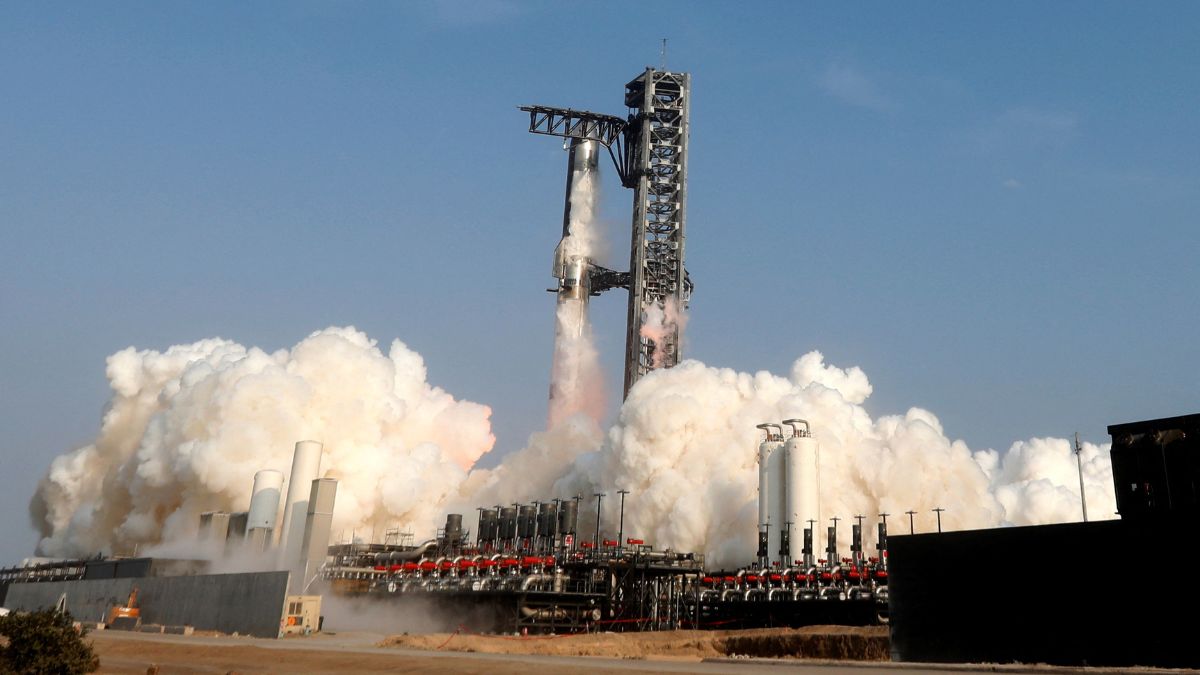SpaceX’s latest attempt to demonstrate the viability of its massive Starship rocket — a crucial step in Elon Musk’s vision of sending humans to Mars — ended in failure once again.
The launch, which took place from the company’s Starbase facility in Texas, marked the ninth integrated flight test of the Starship-Super Heavy system.
While it managed to surpass the distance achieved in earlier attempts, the mission failed to accomplish several critical objectives.
The mission’s objectives included deploying eight Starlink satellite simulators, performing an in-space engine relight and achieving a controlled reentry and splashdown in the Indian Ocean.
Shortly after liftoff, signs of trouble began to emerge. The Super Heavy booster, tasked with propelling the upper-stage spacecraft out of Earth’s atmosphere, failed to complete its planned splashdown in the Gulf of Mexico and instead broke apart mid-descent.
Meanwhile, the upper-stage Starship vehicle continued coasting into suborbital space but experienced fuel leaks and began spiralling out of control before communication was lost entirely.
“Not looking great with a lot of our on-orbit objectives for today,” said SpaceX broadcaster Dan Huot during the company’s livestream.
One of the key failures occurred 18 minutes after launch when the rocket’s mechanism designed to deploy a batch of Starlink satellite simulators malfunctioned.
The payload bay door failed to open, cancelling the planned demonstration. “Starship experienced a rapid unscheduled disassembly,” SpaceX later confirmed, using the company’s typical euphemism for in-flight explosions.
Why Starship is crucial to Musk’s Mars plan
Elon Musk’s goal of making humanity a “multi-planetary species” heavily relies on the success of Starship — the most powerful rocket ever constructed.
The vehicle is designed to be fully reusable and capable of transporting both crew and cargo to the Moon, Mars and beyond. However, despite extensive redesigns and system upgrades across recent test flights, the latest mission’s failure adds to a string of mishaps.
The latest rocket was also the first to fly using a previously flown Super Heavy booster, highlighting SpaceX’s long-term goal of achieving low-cost, rapid reusability.
However, the booster’s steep descent angle and intentional engine shutdown, meant to stress-test performance, ultimately led to its destruction. Starship’s flight continued further than previous tests but still fell short of reaching its designated splashdown zone off the western coast of Australia.
Fuel venting procedures were activated before the vehicle disintegrated roughly 45 minutes into what was supposed to be a 66-minute mission.
Musk noted on X that the rocket’s failure was due to a leak in the primary fuel tank, while also touting “a lot of good data to review” and vowing to accelerate the launch cadence to one every 3–4 weeks.
Still, delays and technical issues raise concerns about SpaceX’s ability to meet future deadlines, including those set by Nasa.
SpaceX’s broader vision includes establishing a human presence on Mars. The company has outlined plans to launch uncrewed missions to Mars as early as 2026, with the goal of building a self-sustaining colony.
These missions would rely on the successful development and operation of the Starship system.
What this means for Nasa’s Moon missions
Nasa has bet heavily on a modified version of the Starship upper stage for its Artemis programme, which aims to return astronauts to the lunar surface. The agency plans to use its Space Launch System and Orion capsule to transport astronauts to lunar orbit, where a waiting Starship will ferry them to and from the Moon.
The first landing mission, Artemis 3, is scheduled for 2027 at the earliest, but that timeline now faces increasing uncertainty.
Complicating matters further is political tension surrounding the Artemis programme itself. The Trump administration has pushed for a reevaluation of Nasa’s current plans, including potential cancellation of the Space Launch System and Orion capsule.
Musk himself has previously argued that lunar missions are a “distraction” and that resources would be better directed straight toward Mars.
Regardless of the destination, successful demonstration flights are essential before Starship can carry astronauts or large cargo payloads into deep space.
The continued failures in test launches indicate SpaceX has considerable ground to cover before it can safely support such missions.
How SpaceX is still on track
While the latest test flight ended with yet another fiery breakup, SpaceX remains committed to its fast-paced, trial-by-fire development philosophy.
The company embraces a “fail fast, learn fast” approach that has helped it dominate commercial spaceflight, and Musk’s confidence in the program appears unshaken — at least publicly.
Fans and enthusiasts gathered at nearby Isla Blanca Park and other vantage points to witness the launch. One tourist from Australia, who travelled with his family to witness the event, described it as “super exciting to see” despite the failure, echoing the sentiment that even unsuccessful missions can yield valuable data, reported AFP.
SpaceX has also made progress on other fronts. The company has successfully caught the Super Heavy booster using giant robotic arms on the launch tower during other recent tests — a feat critical to rapid rocket turnaround and cost reduction, although no such catch attempt was made during this flight.
Regulatory authorities, including the US Federal Aviation Administration (FAA), have recently cleared SpaceX to increase its Starship launch frequency from five to 25 flights annually, even as environmental groups raise concerns about potential harm to local wildlife such as sea turtles and shorebirds.
On another front, Musk is attempting to juggle SpaceX’s technical challenges alongside his broader business and political engagements, including his outspoken support for US President Donald Trump.
Also Watch:
With inputs from agencies
)